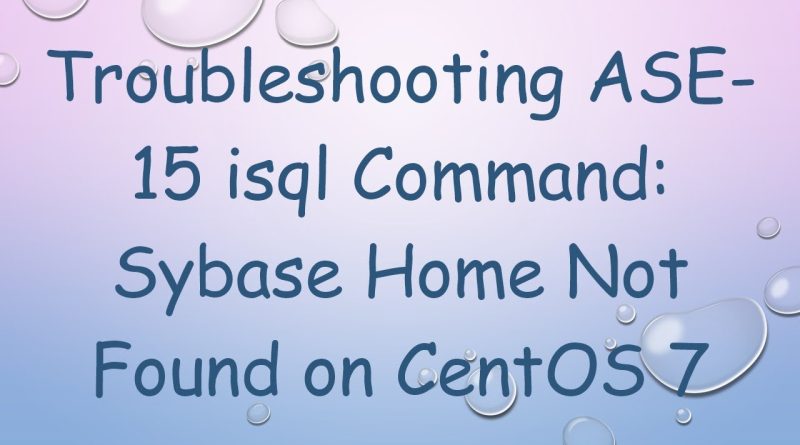Troubleshooting ASE-15 isql Command: Sybase Home Not Found on CentOS 7
Disclaimer/Disclosure: Some of the content was synthetically produced using various Generative AI (artificial intelligence) tools; so, there may be inaccuracies or misleading information present in the video. Please consider this before relying on the content to make any decisions or take any actions etc. If you still have any concerns, please feel free to write them in a comment. Thank you.
—
Summary: Learn how to troubleshoot the ASE-15 isql command issue on CentOS 7 where it fails to locate the Sybase home directory. Follow these steps to ensure proper configuration and environment setup.
—
When working with ASE-15 (Adaptive Server Enterprise) on CentOS 7, you might encounter an issue where the isql command fails to find the Sybase home directory. This problem can arise due to several reasons, including misconfigurations or missing environment variables. Here’s a guide to troubleshoot and resolve this issue effectively.
Understanding the Issue
The isql command is a crucial tool for interacting with the Sybase ASE server. When it cannot locate the Sybase home directory, it typically means that the necessary environment variables are not set correctly or the installation path is not properly configured.
Steps to Resolve the Issue
Verify Sybase Installation Path
First, ensure that Sybase ASE is installed correctly and that the installation path is correctly set. The default installation path for Sybase ASE is usually /opt/sybase. You can verify this by checking if the directory exists:
[[See Video to Reveal this Text or Code Snippet]]
Set Environment Variables
The most common cause of this issue is missing or incorrect environment variables. You need to set the SYBASE and SYBASE_OCS environment variables. You can do this by adding the following lines to your shell profile file (~/.bashrc or ~/.bash_profile):
[[See Video to Reveal this Text or Code Snippet]]
After adding these lines, reload the profile file:
[[See Video to Reveal this Text or Code Snippet]]
Verify Environment Variables
To ensure the environment variables are set correctly, run:
[[See Video to Reveal this Text or Code Snippet]]
These commands should output the paths you have set.
Check Permissions
Make sure that the user running the isql command has the appropriate permissions to access the Sybase installation directory. You can modify the permissions if necessary:
[[See Video to Reveal this Text or Code Snippet]]
Verify isql Binary
Ensure that the isql binary exists in the path defined by the SYBASE and SYBASE_OCS environment variables. You can check this by running:
[[See Video to Reveal this Text or Code Snippet]]
This command should return the path to the isql binary if everything is set up correctly.
Reinstall Sybase ASE (if necessary)
If you have verified all the above steps and the issue persists, consider reinstalling Sybase ASE. Sometimes, a fresh installation can resolve underlying issues that are not immediately apparent.
Conclusion
By following these steps, you should be able to resolve the issue of the isql command not finding the Sybase home directory on CentOS 7. Properly setting and verifying environment variables is crucial for ensuring smooth operation. If problems continue, further investigation into specific system configurations and logs may be necessary.
centos 7



